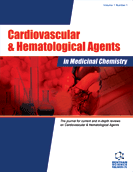Abstract
Chronic angina represents a condition that impairs quality of life and is associated with decreased life expectancy in the industrialized countries. Current therapies that reduce angina frequency include old drugs such as nitrates, β -blockers and calcium antagonists. Several new investigational drugs are being tested for the treatment of chronic angina. This review will focus on ranolazine, a drug approved by the US Food and Drug Administration (FDA) in 2006 for patients with chronic angina who continue to be symptomatic despite optimized therapies. The main molecular mechanism underlying ranolazine-mediated beneficial effects has been identified as inhibition of the late Na+ current during the action potential, which potentially improves oxygen consumption, diastolic dysfunction and coronary blood flow. The aim of this review is to update the evidence for ranolazine treatment in chronic angina and discuss its therapeutic perspectives based on the most recent clinical and experimental studies.
Keywords: Calcium antagonist, coronary artery disease, ranolazine, stable angina, β-blockers, nitrogen.
Cardiovascular & Hematological Agents in Medicinal Chemistry
Title:New Anti-Anginal Drugs: Ranolazine
Volume: 13 Issue: 1
Author(s): Chiara Cavallino, Manuela Facchini, Alessia Veia, Sara Bacchni, Andrea Rognoni, Francesco Rametta, Alessandro Lupi and Angelo S. Bongo
Affiliation:
Keywords: Calcium antagonist, coronary artery disease, ranolazine, stable angina, β-blockers, nitrogen.
Abstract: Chronic angina represents a condition that impairs quality of life and is associated with decreased life expectancy in the industrialized countries. Current therapies that reduce angina frequency include old drugs such as nitrates, β -blockers and calcium antagonists. Several new investigational drugs are being tested for the treatment of chronic angina. This review will focus on ranolazine, a drug approved by the US Food and Drug Administration (FDA) in 2006 for patients with chronic angina who continue to be symptomatic despite optimized therapies. The main molecular mechanism underlying ranolazine-mediated beneficial effects has been identified as inhibition of the late Na+ current during the action potential, which potentially improves oxygen consumption, diastolic dysfunction and coronary blood flow. The aim of this review is to update the evidence for ranolazine treatment in chronic angina and discuss its therapeutic perspectives based on the most recent clinical and experimental studies.
Export Options
About this article
Cite this article as:
Cavallino Chiara, Facchini Manuela, Veia Alessia, Bacchni Sara, Rognoni Andrea, Rametta Francesco, Lupi Alessandro and Bongo S. Angelo, New Anti-Anginal Drugs: Ranolazine, Cardiovascular & Hematological Agents in Medicinal Chemistry 2015; 13 (1) . https://dx.doi.org/10.2174/1871525713666141219112841
| DOI https://dx.doi.org/10.2174/1871525713666141219112841 |
Print ISSN 1871-5257 |
| Publisher Name Bentham Science Publisher |
Online ISSN 1875-6182 |
 64
64 3
3 1
1 1
1
- Author Guidelines
- Bentham Author Support Services (BASS)
- Graphical Abstracts
- Fabricating and Stating False Information
- Research Misconduct
- Post Publication Discussions and Corrections
- Publishing Ethics and Rectitude
- Increase Visibility of Your Article
- Archiving Policies
- Peer Review Workflow
- Order Your Article Before Print
- Promote Your Article
- Manuscript Transfer Facility
- Editorial Policies
- Allegations from Whistleblowers
Related Articles
-
Severe Coagulation Disorder and Thrombocytopenia Associated with Tigecycline – Case Report and Review of Literature
Current Drug Safety Assessing Coronary Blood Flow Physiology in the Cardiac Catheterisation Laboratory
Current Cardiology Reviews Treatment of Chronic Myeloid Leukemia Elderly Patients in the Tyrosine Kinase Inhibitor Era
Current Cancer Drug Targets Lipid Management and Peripheral Arterial Disease
Current Drug Targets Estriol Inhibits Dermcidin Isoform-2 Induced Inflammatory Cytokine Expression Via Nitric Oxide Synthesis in Human Neutrophil
Current Molecular Medicine Mitral Balloon Valvuloplasty: State-of-the-Art Paper
Current Cardiology Reviews Antioxidants in Treating Pathologies Involving Oxidative Damage: An Update on Medicinal Chemistry and Biological Activity of Stobadine and Related Pyridoindoles
Current Medicinal Chemistry Acute Cerebral Blood Flow Variations after Human Cardiac Arrest Assessed by Stable Xenon Enhanced Computed Tomography
Current Neurovascular Research Decreased Vascular Repair and Neovascularization with Ageing: Mechanisms and Clinical Relevance with an Emphasis on Hypoxia- Inducible Factor-1
Current Molecular Medicine The Involvement of PPARs in the Causes, Consequences and Mechanisms for Correction of Cardiac Lipotoxicity and Oxidative Stress
Current Molecular Pharmacology Anti-Seizure Medications and Estradiol for Neuroprotection in Epilepsy: The 2013 Update
Recent Patents on CNS Drug Discovery (Discontinued) Cancer Stem Cells: A Novel Paradigm for Cancer Prevention and Treatment
Mini-Reviews in Medicinal Chemistry Conivaptan: Potential Therapeutic Implications in Heart Failure
Recent Patents on Cardiovascular Drug Discovery Increased Content of Free Phenolic Compounds and Antioxidant Activity of Grape Pomace Cultivated with Three Different β-glucosidase Fungi Producers
Current Bioactive Compounds In Silico hERG Modeling: Challenges and Progress
Current Computer-Aided Drug Design The Effects of CCRC on Cognition and Brain Activity in aMCI Patients: A Pilot Placebo Controlled BOLD fMRI Study
Current Alzheimer Research Potential Therapeutic Effects of Physical Exercise for Bipolar Disorder
CNS & Neurological Disorders - Drug Targets Measurements of Thermodynamic Acid Dissociation Constants for Three HMG-CoA Reductase Inhibitors by using RPLC and Study of Validation in Pharmaceutical Tablets
Current Pharmaceutical Analysis Can Wogonin be Used in Controlling Diabetic Cardiomyopathy?
Current Pharmaceutical Design Evaluating 3D-printed Bolus Compared to Conventional Bolus Types Used in External Beam Radiation Therapy
Current Medical Imaging


























